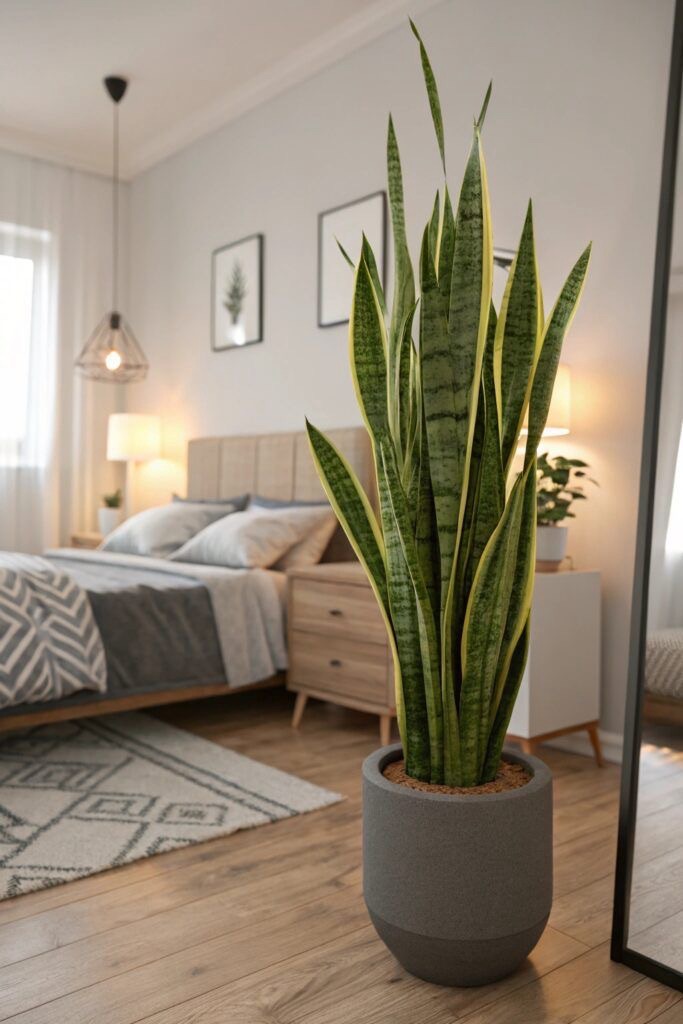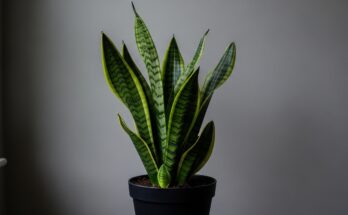
The Snake Plant (Sansevieria trifasciata), also known as Mother-in-law’s Tongue, is one of the most resilient and popular houseplants around the world. Loved for its upright sword-like leaves and air-purifying qualities, it fits effortlessly into homes, offices, and even low-light corners. With a unique blend of low maintenance and health benefits, the snake plant is a favorite for beginners and seasoned plant lovers alike.
🌿 Benefits of Snake Plants
1. Air Purification
The snake plant is one of the top air-purifying plants identified by NASA’s Clean Air Study. It helps remove harmful indoor toxins like:
Formaldehyde (found in cleaning products) Benzene (in paints and glues) Xylene and Toluene (in certain furniture and flooring) Nitrogen oxides and even trace carbon monoxide.
What sets snake plants apart is their ability to convert carbon dioxide into oxygen at night, unlike most plants that do this during the day. This makes them ideal for bedrooms, improving air quality while you sleep.
2. Improves Mental Health
Greenery indoors is linked with reduced stress, anxiety, and mental fatigue. Snake plants contribute to a calm, tranquil space, especially in urban or indoor environments where nature is limited.
3. Low Maintenance
The snake plant can survive in various lighting conditions, infrequent watering, and even neglect. For busy individuals, it’s the perfect “set-it-and-forget-it” houseplant.
4. Humidity Regulation
Snake plants naturally transpire water, slightly increasing indoor humidity. This can help prevent dry skin, sore throats, and even reduce the risk of respiratory infections, especially during dry seasons or in air-conditioned rooms.
5. Aesthetic Appeal
Its tall, architectural shape and green marbled leaves give a modern, elegant touch to any space. There are many varieties—from the common Sansevieria trifasciata to more compact and colorful types like Sansevieria ‘Moonshine’ or Golden Hahnii.
🌱 Snake Plant Care Tips
1. Light Requirements
Snake plants are versatile. They can thrive in:
Bright, indirect light (ideal for faster growth) Low light (perfect for offices or rooms without windows) Direct sunlight (though harsh sun can scorch the leaves)
For optimal growth, place your plant near a north-facing or east-facing window. Avoid long exposure to scorching midday sun, which may bleach or burn the foliage.
2. Watering
The most common mistake with snake plants is overwatering.
Watering Tips:
Water only when the top 2 inches of soil feel completely dry. In summer: about once every 2–3 weeks. In winter: reduce to once a month or less. Always use well-draining soil and pots with drainage holes to prevent root rot. If unsure, it’s safer to underwater than overwater.
3. Soil and Potting
Snake plants prefer loose, sandy, and well-draining soil, such as:
A cactus or succulent potting mix Or a DIY mix of 1 part potting soil, 1 part perlite, and 1 part sand
Avoid dense or clay-rich soils that retain water. Terra cotta pots are ideal as they allow better air circulation and moisture evaporation.
4. Temperature and Humidity
Snake plants are hardy but do best in warm, stable environments:
Ideal temperature: 60°F to 85°F (15°C to 29°C) Avoid temperatures below 50°F (10°C) Protect from cold drafts or sudden temperature drops Normal indoor humidity is fine, but keep away from heating vents or radiators
5. Fertilizing
Feed your snake plant sparingly:
During spring and summer: once a month with a balanced, diluted houseplant fertilizer Avoid overfeeding—too much fertilizer can damage the roots or encourage leggy growth No need to fertilize during fall and winter when growth slows
6. Pruning and Maintenance
Snake plants are tidy, but occasional care helps:
Remove any yellow, dry, or damaged leaves with a clean knife or scissors at the base Wipe leaves with a damp cloth to remove dust and maintain photosynthesis If the plant becomes too crowded, divide the root ball and repot into smaller containers
7. Repotting
Snake plants grow slowly, so repotting is only needed every 2–3 years or when:
Roots start circling the pot The plant becomes top-heavy and unstable
Use a pot only 1–2 inches wider than the current one to avoid excess soil moisture.
🐛 Common Problems and Solutions
1. Root Rot
Cause: Overwatering or poor drainage Fix: Remove affected roots, repot in dry, fresh soil
2. Yellow Leaves
Cause: Too much water, poor light, or nutrient deficiency Fix: Check soil moisture and improve light conditions
3. Drooping or Curling Leaves
Cause: Cold exposure or underwatering Fix: Bring indoors, adjust watering schedule
4. Brown Leaf Tips
Cause: Low humidity, salt buildup, or chemical exposure Fix: Water with filtered water and trim affected tips
5. Pests (Rare)
Occasionally, spider mites or mealybugs may appear. Wipe leaves with:
A mild soap solution Neem oil spray Or rubbing alcohol on a cotton pad
🌼 Propagation Tips
Snake plants are easy to propagate through:
Leaf cuttings in water or soil: Cut a healthy leaf, let it dry, then insert into water or moist soil Division: Remove plant from the pot, split the root clump with at least 3 leaves and roots each
Propagation works best during the growing season (spring to summer).
🏠 Where to Place Your Snake Plant
Bedroom: For clean oxygen at night Bathroom: If bright, snake plants can tolerate humidity Office desk: Improves concentration and purifies stagnant air Living room corner: Makes a striking design element
Just be cautious around pets and children—snake plants are mildly toxic if ingested


